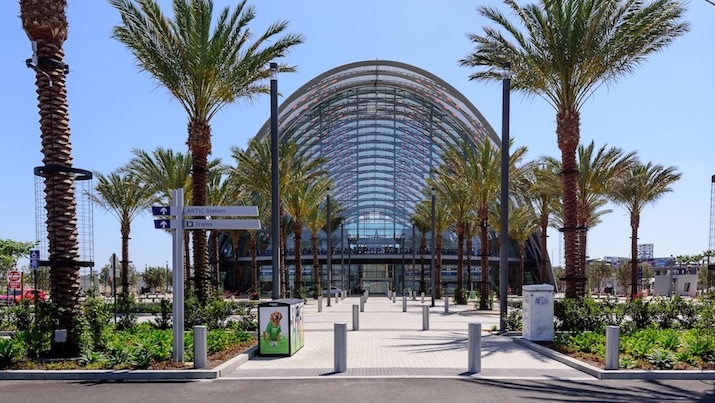HOK, the international architecture, engineering, and planning firm, will promote its President and 25-year company veteran Bill Hellmuth, AIA, to the position of Chief Executive Officer, effective April 19.
Hellmuth, who is the nephew of the firm’s founder George Hellmuth (its initials are an acronym for Hellmuth, Obata & Kassabaum), has been President since 2005. When he steps into the CEO post, he will replace Patrick MacLeamy, FAIA, LEED AP, who has served as HOK’s chief for 13 of the 49 years he’s been with the firm.
MacLeamy will remain as HOK’s chairman. During his HOK career, MacLeamy has overseen the establishment of several HOK regional offices in the U.S. and Asia. He has held leadership roles on several landmark HOK projects, including the Moscone Convention Center in San Francisco and King Khalid International Airport in Riyadh, Saudi Arabia.
In a statement, Hellmuth identified HOK’s “sweet spot” as “the intersection of design excellence and thought leadership, combining design leadership with expertise in specific markets and building types around the world.”
HOK has 1,800 employees (it is 100% employee owned) in 24 offices worldwide. It has current projects in 75 countries.
Hellmuth has a total of 37 years experience in the architecture industry, including a stint with Skidmore, Owings and Merrill. He joined HOK’s St. Louis office in 1991, and two years later was promoted to lead HOK’s Washington, D.C. office. He joined the firm’s executive committee in 2004.
A strong advocate for sustainable design, Hellmuth began integrating sustainability into every project before LEED certification became a benchmark. In 2014 he was named Senior Fellow of the Design Futures Council, and a GSA Design Excellence Peer.
Related Stories
| Nov 29, 2010
Data Centers: Keeping Energy, Security in Check
Power consumption for data centers doubled from 2000 and 2006, and it is anticipated to double again by 2011, making these mission-critical facilities the nation’s largest commercial user of electric power. Major technology companies, notably Hewlett-Packard, Cisco Systems, and International Business Machines, are investing heavily in new data centers. HP, which acquired technology services provider EDS in 2008, announced in June that it would be closing many of its older data centers and would be building new, more highly optimized centers around the world.
| Nov 29, 2010
New Design Concepts for Elementary and Secondary Schools
Hard hit by the economy, new construction in the K-12 sector has slowed considerably over the past year. Yet innovation has continued, along with renovations and expansions. Today, Building Teams are showing a keener focus on sustainable design, as well as ways to improve indoor environmental quality (IEQ), daylighting, and low-maintenance finishes such as flooring.
| Nov 29, 2010
Renovating for Sustainability
Motivated by the prospect of increased property values, reduced utility bills, and an interest in jumping on the sustainability bandwagon, a noted upturn in green building upgrades is helping designers and real estate developers stay busy while waiting for the economy to recover. In fact, many of the larger property management outfits have set up teams to undertake projects seeking LEED for Existing Buildings: Operations & Maintenance (LEED-EBOM, also referred to as LEED-EB), a certification by the U.S. Green Building Council.
| Nov 23, 2010
The George W. Bush Presidential Center, which will house the former president’s library
The George W. Bush Presidential Center, which will house the former president’s library and museum, plus the Bush Institute, is aiming for LEED Platinum. The 226,565-sf center, located at Southern Methodist University, in Dallas, was designed by architect Robert A.M. Stern and landscape architect Michael Van Valkenburgh.
| Nov 23, 2010
Honeywell's School Energy and Environment Survey: 68% of districts delayed or eliminated improvements because of economy
Results of Honeywell's second annual “School Energy and Environment Survey” reveal that almost 90% of school leaders see a direct link between the quality and performance of school facilities, and student achievement. However, districts face several obstacles when it comes to keeping their buildings up to date and well maintained. For example, 68% of school districts have either delayed or eliminated building improvements in response to the economic downturn.
| Nov 16, 2010
Architecture Billings Index: inquiries for new projects remain extremely high
The new projects inquiry index was 61.7, down slightly from a nearly three-year high mark of 62.3 in September, according to the Architecture Billings Index (ABI). However, the ABI dropped nearly two points in October; the October ABI score was 48.7, down from a reading of 50.4 the previous month. The ABI reflects the approximate nine to 12 month lag time between architecture billings and construction spending.
| Nov 16, 2010
Brazil Olympics spurring green construction
Brazil's green building industry will expand in the coming years, spurred by construction of low-impact venues being built for the 2016 Olympics. The International Olympic Committee requires arenas built for the 2016 games in Rio de Janeiro meet international standards for low-carbon emissions and energy efficiency. This has boosted local interest in developing real estate with lower environmental impact than existing buildings. The timing couldn’t be better: the Brazilian government is just beginning its long-term infrastructure expansion program.
| Nov 16, 2010
Green building market grows 50% in two years; Green Outlook 2011 report
The U.S. green building market is up 50% from 2008 to 2010—from $42 billion to $55 billion-$71 billion, according to McGraw-Hill Construction's Green Outlook 2011: Green Trends Driving Growth report. Today, a third of all new nonresidential construction is green; in five years, nonresidential green building activity is expected to triple, representing $120 billion to $145 billion in new construction.











